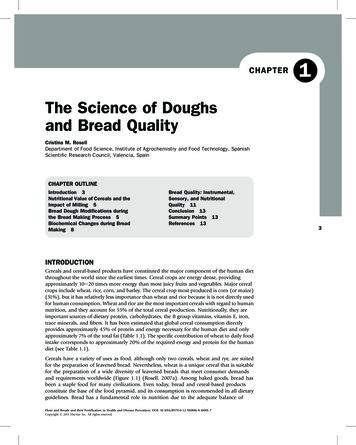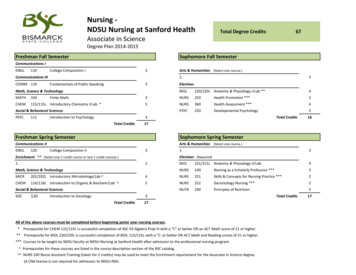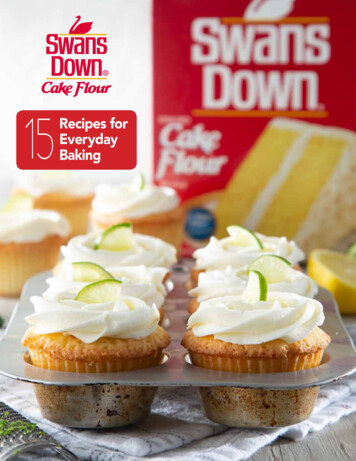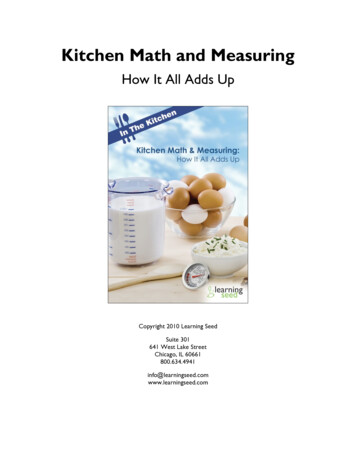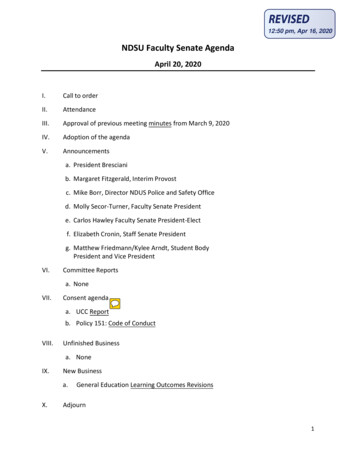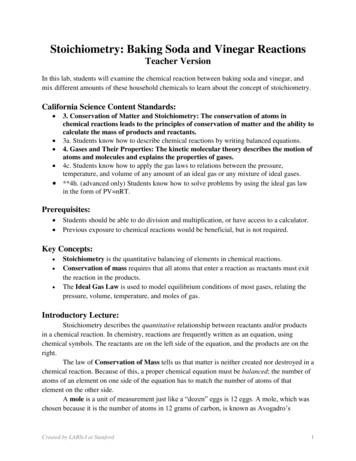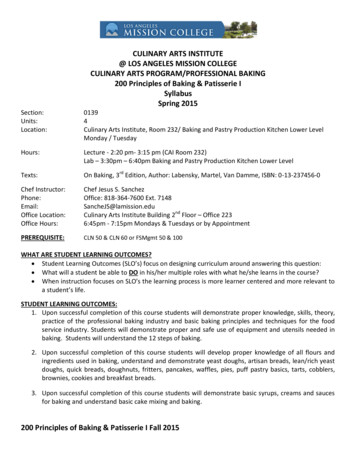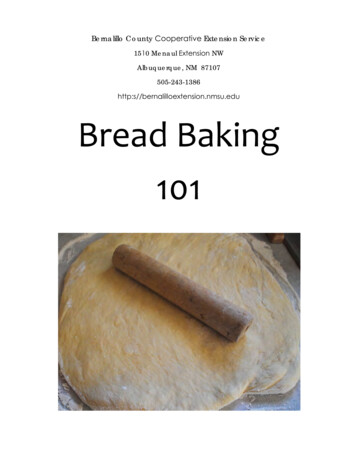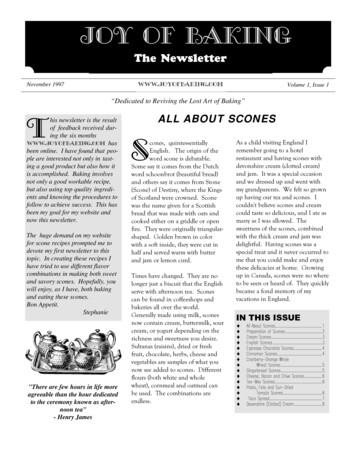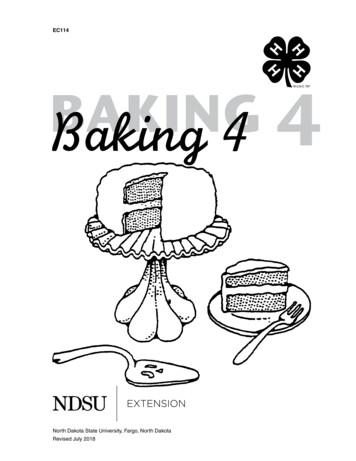
Transcription
EC114BAKING4Baking 4North Dakota State University, Fargo, North DakotaRevised July 2018
Cakes, Pies and PastriesBy Louise Garrett, Extension nutrition specialistRevised by Martha Anderson, Extension specialist, 4-HNew Mexico State UniversityAdapted in North Dakota by the 4-H Healthy Livestyles Programming Commitee:Marcia Hellendsaas, McKenzie and Dunn County Extension Agent - Nutrition, Food Safety and HealthGail Slinde, Ward County Extension Agent - 4-H Youth DevelopmentKaylyn Anderson, LaMoure County Extension Agent - 4-H Youth Development/Nutrition EducationMacine Lukach, Cavalier County Extension Agent - Nutrition, Food Safety and HealthHeather Hagen, Former Cass County 4-H MemberDeb Hagen, Cass County 4-H Volunteer LeaderJane Edwards, Extension Nutrition Specialist, NDSU Department of Health, Nutrition andExercise SciencesJulie Garden-Robinson, Extension Food and Nutrition Specialist, NDSU Department of Health,Nutrition and Exercise SciencesCarrie Stark, 4-H Youth Development Specialist, NDSU Extension Service, Center for 4-H YouthDevelopmentRevised June 2016 by Julie Garden-Robinson, Extension Food and Nutrition SpecialistReferencesBetter Homes and Gardens New Baking Book (1999). Des Moines, Iowa: Meredith Books.Betty Crocker’s Picture Cook Book (1956). New York: McGraw-Hill.Cocinas de New Mexico (1976). Albuquerque, N.M.: Public Service Company of New Mexico.Dickson, Darlene (April 5, 1992). “A Tasty Recipe for Meringue Pie,” Clovis News Journal, p. 4D.Favorite Brand Name Pie Collection (1993). Lincolnwood, Ill.: Publications International Limited.Foodworks (1993). West Lafayette, Ind.: Purdue University Cooperative Extension Service.How to Master the Art of Pastry Making. (No date available.) General Mills booklet.Nusom, Lynn (1991). Christmas In New Mexico. Phoenix, Ariz.: Golden West Publications.Nusom, Lynn (March 7, 2000). “Round Out Your Pie-Making Skills,” Las Cruces–Sun News, p. A10.2
ContentsIntroduction . 4Eating Well . 5Cake Science .11Let’s Bake a Cake . 12Yellow Cake . 12Sponge Cake .13Cake Finishes .15Uncooked Butter Frosting .15Seven-minute Frosting .15Fudge Frosting .16Busy Day Oatmeal Cake.17Mixes . 18Other Important Things to Do .19Let’s Make Pastry . 20Basic Recipe for Pastry (from solid shortening) . 21Great Ideas With Pastry . 29Pie Fillings .31Thickening Agents. 35Cream Pies . 38Custard Pies . 44Fruit Pies . 47Meat Pies, Cheese Pies, Little Pies and More .51Freezing Pies and Pastry Products . 55Troubleshooting Pastry. 56Homemade or Ready-Made?.57Baking Record Form . 593
IntroductionAbout CakesPastry and PiesCakes are sweetened breads. Because of the extraamount of sugar and fat, you can mix cake batteruntil it is smooth and the cake will not be tough.Sugar and fat condition the gluten in the flourto make a tender product. (Overhandling breaddough causes toughness.)“As American as apple pie” — that’s an expressionwe’ve often heard. Americans like pie whetherit’s apple, lemon, cherry, chocolate, pumpkin,pecan or mince. Pie is America’s favorite dessert;a homemade pie is the crowning touch to awonderful meal.Baking powder and eggs make cakes light. Whenyou beat eggs separately and fold them into thecake batter, the air you beat into the eggs, plusthe carbon dioxide gas from baking powder, canresult in a cake that has a delicate, fine grain andis tender and moist.We use the word “pie” in many commonexpressions in our everyday speech, such as “sweetas pie,” “pie in the sky,” “eating humble pie” and“easy as pie.” A flaky pastry filled with flavorfulfruit; a delicious, cream filling; or meat and cheeseis a delight! No wonder some people say they likeonly two kinds of pie — hot and cold!To make a good cake, you must measure carefullyand follow the directions for mixing and bakingexactly.In this project, you will learn to make: Tender, flaky pastry that has good flavor Flavorful cream, custard and fruit fillings Attractive meringue Pastries such as turnovers, empanadas andquicheTwo types of cakesCakes come in two types — butter and sponge.Butter cakes are made with fat; sponge cakes aremade without fat.You will do the following to complete the project: Make pastry using several different mixingmethods Experiment with various fats used in makingpastry Perform viscosity experiments Prepare cream fillings thickened with variousproducts Prepare attractive meringue for cream pies Prepare custard fillings Prepare fruit fillings using fresh andcanned fruits Experiment with pastry/pie variationsAs the name tells you, butter was used most oftenas the fat in cakes at one time. You also can useany vegetable shortening in these cakes. Manypeople prefer butter for the delicacy of flavor, butthe cost may be too high for the average family.True sponge and angel cakes are made withoutfat or baking powder. Air and steam are theleavening agents. You beat the egg whites so theyhold as much air as possible, and then fold themcarefully into the cake batter. As the cake bakes,the heat makes imprisoned air expand, and thiscauses the cake to rise. As the liquid in the batterheats, steam forms. This steam expands like thetrapped air and also helps leaven the cake.Angel or white sponge cakes are made with eggwhites only. Yellow sponge cake is made with thewhole egg.Suggested Exhibits:1. One 8-inch or 9-inch fruit pie withdouble crust2. Two fruit-filled turnovers or empanadas3. A viscosity display including experiment resultsheets and line spread viscometer, laminated orenclosed in plastic cover4. Sponge Cake5. Butter Cake4
Eating WellMyPlate Speaks“MyPyramid” has been rebuilt and it’s now aplate! Here’s what the colors stand for:Let’s look at some of the other messages this newsymbol is trying to send:orange - grainsgreen - vegetablesred - fruitsblue - dairy foodspurple - protein foodsBalancing Calories Enjoy your food, but eat less. Avoid oversized portions.The U.S. Department of Agriculture (USDA)wanted an easier way to remind people to eathealthfully. MyPlate shows the five food groupsusing a familiar picture: a place setting with aplate, cup and fork.Foods to Increase Make half your plate fruits and vegetables. Make at least half your grains whole grains. Switch to fat-free or low-fat (1%) milk.Foods to Reduce Compare sodium in foods such as soup, breadand frozen meals. Choose foods with lowernumbers. Drink water instead of sugary drinks.Make it personal.Through the USDA’s MyPlate website(www.choosemyplate.gov), you can getpersonalized recommendations about the mix offoods you need to eat and how much you shouldbe eating.5
How Much Do I Need to Eat?FruitsEveryone wants to know how much he orshe should eat to stay healthy. That’s a trickyquestion, though. It depends on your age,whether you’re a girl or boy, and how active youare. Kids who are more active burn more calories,so they need more calories. But we can give yousome estimates for how much you need of eachfood group.Sweet, juicy fruit definitely is part of a healthy diet.Here’s how much you need: 4- to 8-year-olds need 1 cup to 1½ cups of fruiteach day. 9- to 13-year-old girls need 1½ cups of fruit eachday. 9- to 13-year-old boys need 1½ cups of fruit eachday.GrainsDairy FoodsGrains are measured in ounce equivalents. Whatare they? Ounce equivalents are just another wayof showing a serving size.Dairy foods are rich in calcium to build strongbones to last a lifetime. 4- to 8-year-olds need 1 to 2 cups of milk (or othercalcium-rich food) each day. 9- to 13-year-old girls need 3 cups of milk(or other calcium-rich foods) each day. 9- to 13-year-old boys need 3 cups of milk(or other calcium-rich foods) each day.Here are ounce equivalents for common grainfoods. An ounce equivalent equals:1 piece of bread½ cup of cooked cereal, such as oatmeal½ cup of rice or pasta1 cup of cold cerealIf you want something other than milk, you cansubstitute yogurt, cheese or calcium-fortifiedorange juice — just to name a few. 4- to 8-year-olds need 4 to 5 ounceequivalents each day. 9- to 13-year-old girls need 5 ounceequivalents each day. 9- to 13-year-old boys need 6 ounceequivalents each day.Protein FoodsThese foods contain iron and lots of otherimportant nutrients. Like grains, these foods aremeasured in ounce equivalents.And one last thing about grains: Make at leasthalf your grain food choices whole grains, suchas 100 percent wheat bread, brown rice andoatmeal.An ounce equivalent of this group would be:1 ounce of meat, poultry or fish¼ cup cooked dry beans1 egg1 tablespoon of peanut buttera small handful of nuts or seedsVegetablesOf course, you need your vegetables, especiallythose dark green and orange ones. But how muchis enough? Vegetable servings are measuredin cups. 4- to 8-year-olds need 3 to 4 ounceequivalents each day. 9- to 13-year-old girls need 5 ounceequivalents each day. 9- to 13-year-old boys need 5 ounceequivalents each day. 4- to 8-year-olds need 1½ cups of veggies eachday. 9- to 13-year-old girls need 2 cups of veggieseach day. 9- to 13-year-old boys need 2½ cups of veggieseach day.Whoa! That’s a lot to swallow. The good news isthat your mom, dad and the other grownups inyour life will help you eat what you need to stayhealthy. Here’s more good news: You don’t have tobecome a perfect eater overnight.Adapted with permission fromhttp://kidshealth.org/kid/stay healthy/food/pyramid.html6
United States Department of Agriculture10tipsNutritionEducation Seriesenjoy your food,but eat less10 tips to enjoying your mealYou can enjoy your meals while making small adjustments to the amounts of food on your plate.Healthy meals start with more fruits, vegetables, grains, protein foods, and dairy. Drink and eat less sodium,saturated fat, and added sugars.16get to know the foods you eatUse the SuperTracker to find out what kinds of foodsand how much to eat and to get tips and support formaking better food choices.2Choose more vegetables, fruits, whole grains, andfat-free or 1% milk and dairy products. Cut back on foodshigh in solid fats, added sugars, and salt.Be mindful to eat slowly, enjoy the taste andtextures, and pay attention to how you feel. Usehunger and fullness cues to recognize when to eat andwhen you’ve had enough.738take your timeuse a smaller plateif you eat out, choose healthier options910compare foodsIndulge in a naturally sweet dessert dish—fruit!Serve a fresh fruit cocktail or a fruitparfait made with yogurt. For a hot dessert,bake apples and top with cinnamon.USDA is an equal opportunity provider and employer.FAT FREECheck out the Food-A-Pedia to look up and comparenutrition information for more than 8,000 foods.satisfy your sweet tooth in a healthy wayCenter for Nutrition Policy and Promotionsip smarterDrink water or other calorie-freebeverages, 100% juice, or fat-freemilk when you are thirsty. Soda and othersugar-sweetened beverages containadded sugar and are high in calories.Check and compare nutrition information aboutthe foods you are eating. Preparing food at homemakes it easier to control what is in your meals.5find out what you needGet your personalized plan by using the SuperTrackerto identify your food group targets. Compare the foodsyou eat to the foods you need to eat.Use a smaller plate at meals to help with portioncontrol. That way you can finish your entire plate andfeel satisfied without overeating.4choose to eat some foodsmore or less oftenmake treats “treats,”not everyday foodsTreats are great once in a while. Just don’t maketreat foods an everyday choice. Limit sweet treats to specialoccasions.Go to www.ChooseMyPlate.govfor more information.7DG TipSheet No. 18Revised January 2016
United States Department of Agriculture10tipsNutritionEducation Serieschoosingwhole-grain foods10 tips for purchasing and storing whole-grain foodsWhole grains are important sources of nutrients such as zinc, magnesium, B vitamins, andfiber. There are many choices available to make half your grains whole grains. But whole-grain foods should behandled with care. Over time and if not properly stored, oils in whole grains can cause spoilage. Consider thesetips to select whole-grain products and keep them fresh and safe to eat.16search the labelWhole grains can be an easy choicewhen preparing meals. Choosewhole-grain breads, breakfast cereals,and pastas. Look at the Nutrition Factslabels and ingredients lists to find choiceslower in sodium, saturated (solid) fat, and added sugars.2Buy whole-grain products that are tightly packagedand well sealed. Grains should always look and smellfresh. Also, check the expiration date and storage guidelineson the package.78Your kids can choose whole grains at school.Encourage healthier choices at home by addingwhole grains into their favorite recipes, meals, and snacks.9wrap it upWhole-grain bread is best stored at room temperaturein its original packaging, tightly closed with a quicklock or twist tie. The refrigerator will cause bread to losemoisture quickly and become stale. Properly wrappedbread will store well in the freezer.find the fiber on labelIf the product provides at least 3 grams of fiber perserving, it is a good source of fiber. If it contains 5 ormore grams of fiber per serving, it is an excellent source of fiber.10is gluten in whole grains?what’s the shelf life?Since the oil in various whole-grain floursdiffers, the shelf life varies too. Most whole-grainflours keep well in the refrigerator for 2 to 3 months and inthe freezer for 6 to 8 months. Cooked brown rice can berefrigerated 3 to 5 days and can be frozen up to 6 months.People who can’t eat wheat gluten caneat whole grains if they choose carefully.There are many whole-grain products, such asbuckwheat, certified gluten-free oats or oatmeal,popcorn, brown rice, wild rice, and quinoa that fitgluten-free diet needs.USDA is an equal opportunity provider and employer.buy what you needPurchase smaller quantitiesof whole-grain products toreduce spoilage. Most grains insealed packaging can be kept inthe freezer.kids can choose whole grainsCenter for Nutrition Policy and Promotionkeep a lid on itWhen storing whole grains from bulk bins, usecontainers with tight-fitting lids and keep in a cool,dry location. A sealed container is important for maintainingfreshness and reducing bug infestations.look for the word “whole” at thebeginning of the ingredients listSome whole-grain ingredients include whole oats,whole-wheat flour, whole-grain corn, whole-grain brownrice, and whole rye. Foods that say “multi-grain,” “100%wheat,” “high fiber,” or are brown in color may not be awhole-grain product.345check for freshnessGo to www.ChooseMyPlate.govfor more information.8DG TipSheet No. 22Revised January 2016
Why Do We Eat?Nutrients — Who Needs Them?We know everyone needs food to live.But why?Nutrients are chemical substances that yourbody gets from the food you eat. Each nutrienthas a different job to do. They all are necessary inspecific amounts, but your body knows how tohandle it all! You’re an amazing machine!Food gives you two things: Energy to move and to do things Stuff to help you grow and stay healthy Vitamin A helps you see in the dark.Just like a car needs fuel to run, your body needsfood for energy. Without energy, you couldn’trun or play. Water regulates body temperature. Calcium builds strong bones and teeth. Fat gives you energy and carries some vitaminsto where the body needs them.Besides giving you energy, food helps you growand heal. When you skin a knee or an elbow, yourbody needs to fix or replace the skin you scrapedoff. If you get sick, your body needs to fight theinfection, rebuild weak body parts and get well.Your body also keeps you from getting too hot orcold. Nutrients are the things in food that helpyour body perform all these functions. So yourbody doesn’t need just the food, it needs the nutrients in the food. Iron helps your blood carry oxygen to all partsof your body — even your toes! Protein builds and repairs muscles and otherparts of your body. Vitamin C helps heal cuts. Carbohydrates give you energy to grow, moveand do things.9
Cake ScienceLet’s Experiment!Does the pan make a difference in baking food?Cakes and cookies are similar in that they are delicate in flavor and texture.(You can do this experiment with cookies and note the results for both kinds ofbaked products.)Materials Needed1 roll of sugar-cookie dough bought at store1 sharp slicing knife1 shiny baking sheet (pie pans can be used)1 dark-dull baking sheetProcedure1. Place oven rack in the center position of the oven.2. Preheat oven to the temperature stated on the cookie package.3. Open cookie dough and slice eight cookies off the roll. Try to make slices asmuch alike as possible.4. Place four cookies on the shiny pan and four cookies on the dark-dull pan.5. Bake only one pan of cookies at a time. Start with the shiny pan. Check thetime. Place the cookies near the center of the oven. Bake until light brownand done. Write down the exact number of minutes they bake. Removecookies from pan to cool. Bake cookies on the dark-dull pan. Bake them inthe same spot in the oven and for exactly the same number of minutes as youused for the cookies on the shiny pan. Remove cookies from pan to cool.ObservationAfter cookies cool, compare the color and texture.QuestionsWhat difference can you see in color, especially on the bottom of the cookies?Break cookies in half. What is the difference in the texture of the cookies?Which pan absorbed more heat?What kind of pan should be used for a delicate white cake?10
Let’s Experiment! What are some differencesbetween all-purpose flour and cake flour?Materials NeededAll-purpose flourCake flourSheet of blue or white paperWaxed paperFlour sifter1/2 cup measuring cup2 small bowls, same size and shapeLiquid measuring cupTwo metal mixing spoons, both alikeProcedure and ObservationsPlace 1 Tbsp. all-purpose flour and 1 Tbsp. cake flour side by side on a piece ofblue or white paper. Describe any difference you observe. Rub a pinch of eachflour between your thumb and finger. (Be sure your fingers are dry.) If you feelany difference, describe it.In this part of the experiment, you will mix two simple flour and water pastes,one with all-purpose flour and the other with cake flour. Follow these steps:1. Place two small bowls side by side on the table. Sift and measure 1/2 cupall-purpose flour. Put in one bowl. Sift and measure 1/2 cup cake flour.Put in other bowl. Label bowls.2. Measure 1/4 cup cold water and pour into the all-purpose flour. Stir untilall flour is dampened.3. Measure another 1/4 cup cold water and pour into the cake flour. Stiruntil all flour is dampened.4. Stir the mixture in each bowl 50 strokes.QuestionsWhich flour absorbed more liquid?What difference did you notice between the two flour-water mixtures?If a recipe calls for 1 cup of cake flour, but you use 1 cup of all-purpose flourinstead, what might be the result with the baked cake?Why do directions sometimes tell you to use 7/8 cup of all-purpose flour inplace of 1 cup cake flour?Why is following the directions given in a recipe for mixing so important?11
Let’s Bake a CakeYellow CakeEveryday and Sunday, too, it’s that kind of cake. If you can keep hands off, it will staymoist for several days. Frost and fill it with yummy fudge frosting.Preheat oven to 375 F.Use three 8-by-1½-inch round layer pans. Cut waxed papers to fit bottoms of pans.Be sure these papers lie flat and do not wrinkle at sides. Grease tops of papers andplace in pans. Do not grease sides of pans.Ingredients3 cups sifted cake flour2¼ tsp. double-acting baking powder(at elevations of 7,000 feet or more,use only 1¾ tsp. baking powder)1 cup butter*1½ cups sugar2 tsp. vanilla4 egg yolks1¾ cups milk4 egg whites* You can use hydrogenated vegetable shortening in place of butter if you add 1/2 tsp. salt,sifted with flour and baking powder.1. Sift flour, then measure. Add baking powder to flour and sift together threetimes. Set aside.2. Stir butter to soften. Add sugar gradually and cream together thoroughly.3. Blend in vanilla.4. Add egg yolks, one at a time, blending thoroughly after each.5. Add flour and milk alternately, beginning and ending with flour. Add flour infour portions, milk in three. Mix after each addition at lowest speed until justblended. Beat one minute at a medium speed after last addition of flour. (Ifmixing by hand, stir each addition until just blended. Beat 35 strokes after firstthree additions of flour. After last addition of flour, beat 70 strokes.)6. Beat egg whites until they begin to hold a peak that stands straight up when yougently lift the beater. With a mixing spoon, fold egg whites into mixture; use 30to 40 strokes.7. Pour batter into pans lined with waxed paper. Spread from center so batter isslightly higher at edges.8. Bake in 375 F oven about 30 minutes, or until cake springs back when lightlypressed.9. Remove from oven. Immediatelyloosen layers from pans by runninga thin spatula around the edges.Turn layers onto wire racks to cooland immediately lift off waxedpaper.10. Cover tightly or wrap the cooledcake to prevent drying.12
Sponge CakeWhether you call this a sponge cake or yellow angel food cake makes no difference. It’splain golden, delicious eating. What’s it like outside and in?Outside it is golden brown from top to bottom and about 3 inches high. Inside it’s tenderand light, with small, slightly irregular air spaces.Preheat oven to 375 F.Use ungreased 10-inch tube pan.Ingredients1¼ cups sifted cake flour1/2 tsp. salt1/4 tsp. double-acting baking powder1 cup sugar(at elevations of 7,000 feet or more,take out 2 Tbsp. sugar)3/4 cup egg whites (about six)1¼ tsp. cream of tartar1/2 cup sugar1/2 cup egg yolks (about six)1/4 cup water1 tsp. vanilla1 tsp. lemon extract1. Sift flour, then measure. Add salt, baking powder and 1 c. sugar to flour and sift togetherinto small bowl. Set aside.2. Beat egg whites until foamy. Add cream of tartar. Beat until very soft peaks form. Peaksturn over slightly when you lift the beater slowly from beaten egg whites. Use a handrotary beater for better volume in baked cake.3. Add 1/2 cup sugar gradually by sprinkling 2 Tbsp. at a time over whites. Beat after eachaddition. After beating last addition, the eggs and sugar mixture should form stiff peaks.4. To flour mixture, add yolks, water, vanilla and lemon extract. Mix until flour isdampened. Then beat with electric beater two to three minutes or with hand rotarybeater three to four minutes until yolk mixture is very thick. When you lift the beater,yolk mixture should mound slightly. The thicker the mixture, the better the volume ofthe baked cake.5. Pour the flour and yolk mixture into the beaten whites and fold in, using a rubberspatula. Use 30 to 40 fold-over strokes.6. Pour batter into ungreased tube pan. Using a circularstroke, cut gently through batter two orthree times with knife to remove largeair bubbles.7. Bake in 375 F oven about 35 to 40minutes or until cake springs backwhen you press it lightly.8. Remove cake from oven. Invert panon wire rack and let stand untilcool.9. When cool, loosen cake fromsides and tube with spatula;gently remove from pan.10. Cover tightly or wrap thecooled cake to preventdrying. Store upside down.13
How does your cake rate?Reasons for Butter CakeFailuresReasons for Sponge CakeFailuresUndersizedToo little leavening agentToo large a panOven too hotOvermixingTough CakeOven too hotNot enough sugarOvermixingCoarse TextureUnderbeaten egg whitesToo slow an ovenIngredients not blended well enoughTough CrustsToo much flourToo little sugar or shorteningOven too hotCake baked too longHeavy Sticky Layer at BottomEgg yolks not beaten enoughInsufficient mixing of yolks with otheringredientsFallen CakeToo much sugarToo much shorteningInsufficient bakingCracks in CrustOverbeating egg whitesToo much sugarToo hot an ovenSoggy or Heavy BottomUndermixingToo little leaveningLower part of oven too coolToo much liquidSticky CrustToo much sugarUnderbakingCourse-grainedInsufficient creamingToo much leaveningAll-purpose rather than cake flourOven too slowUndersized CakeUnderbeaten or overbeaten egg whitesOvermixingToo large a panToo hot an ovenRemoved from pan too soon14
Cake FinishesFrosting adds beauty and appetite appeal, and complements the flavor of the cake.Frostings fall into two general categories — creamy and fluffy.Creamy frosting has a soft, lustrous, smooth surface. Uncooked butter frosting ispopular. Other creamy frostings, such as fudge and penuche, are cooked, cooled andbeaten to a creamy consistency.Fluffy frostings have a glossy surface and are light and fluffy. You make the mostfamiliar of these, seven-minute frosting, in a double broiler. A fluffy frosting will seton the surface, but remain soft underneath.Be sure cakes are cool before frosting. Brush off all loose crumbs so they will not causefrosting to look bumpy.Uncooked Butter Frosting1/3 cup soft butter or margarine3 cups confectioners’ sugar3 Tbsp. (approximately) cream or rich milk1 tsp. vanilla1. Cream butter or margarine and gradually add the sugar. Mix until blended.2. Add vanilla and enough cream or milk so frosting will spread easily, but not run.3. If desired, add coloring to all or part of this frosting. Be careful to use only a smallamount of the food coloring so the frosting will have a very delicate tint.Variations Add 3 ounces (three squares) unsweetened chocolate, melted. Use 1 Tbsp. grated rind and 3 Tbsp. orange or lemon juice instead of vanillaand cream.Seven-minute Frosting3/4 cup sugar1 egg white1/2 tsp. vanilla1/8 tsp. cream of tartar3 Tbsp. water1/4 tsp. almond extract (if desired)1. Mix all ingredients, except extracts, in top of double broiler. Beat until blended.2. Place over boiling water and beat rapidly until frosting holds a peak.3. Add extracts. Spread on cooled cake.15
Fudge Frosting2 squares unsweetened chocolate2 cups sugar2 Tbsp. light corn syrup1 tsp. vanilla1 cup milk1/8 tsp. salt2 tsp. butter or margarine1. Combine chocolate and milk in medium-sizedsaucepan. Place over low heat and cook until mixtureis smooth and well-blended, stirring constantly.2. Add sugar, salt and corn syrup. Stir until sugar isdissolved and mixture boils. Continue boiling,without stirring, until a small amount of mixtureforms a very soft ball in cold water.3. Remove from heat. Add butter or margarine andvanilla. Cool until lukewarm.4. Beat until of creamy consistency that you can spreadon the cake. If necessary, place over hot water to keepsoft while spreading.16Good cakestaste greatwith fresh fruit,gentle glazes orwhipped creamas a spectacularfinish, too.Fruit has morenutrition, lessfat, and is betterfor your teethas well!
Busy Day Oatmeal CakeIngredients1 cup oatmeal, quick1¼ cups boiling waterPour water over oats and let stand while mixing the following:1 cup sugar½ cup shortening2 eggs1½ cups plain flour1 tsp. vanilla1 tsp. cinnamon1 tsp. nutmeg1 tsp. allspice1 tsp. soda½ tsp. saltDirections1. Preheat oven to 350 F.2. Cream sugar and shortening. Add eggs; beat.3. Add flour, oatmeal, vanilla and spices.4. Pour into floured 9- by 13-inch pan.5. Bake at 350 degrees for 30 to 35 minutes or until done.6. Cool cake before icing.Icing for Oatmeal Cake (optional)Ingredients1 cup brown sugar½ stick butter4 to 5 Tbsp. evaporated milkDirections1. Boil one minute and add 1 cup coconut and ½ cup nuts(optional). Spread on top of cake.2. Broil a few minutes until lightly browned.Makes 12 servingsPer serving: 210 calories, 30 g carbohydrates, 10 g fat, 2 g fiber and120 mg sodium(With icing: 380 calories, 50 g carbohydrates, 20 g fat, 2 g fiber and170 mg sodium)17
MixesCheck your grocery store and see how many packaged mixes you find for:yellow butter cakesponge cakefluffy white frostingchocolate frostingSelect a package mix of your choice from the above group. Prepare it at home.How did it compare with “scratch” products you made in:costflavortime of preparationkeeping qualitynumber of servingsWhen would you use the “scratch” method for family meals? The mix?18
Other ImportantThings to DoDemonstrations Give a demonstration on how to make a cake or food science.Citizenship Help with a food drive Visit a nursing home. Call first
4. Sponge Cake 5. Butter Cake About Cakes Cakes are sweetened breads. Because of the extra amount of sugar and fat, you can mix cake batter until it is smooth and the cake will not be tough. Sugar and fat condition the gluten in the flour to make a tender product. (Overhandling bread dough
